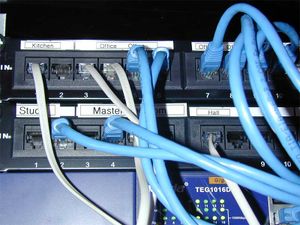Structured wiring system
| ||
| If you are thinking of editing this page please be aware that the original author(s) of this page may be actively working on it at this moment, so changes you make may clash with theirs. (The Wiki software will warn you of conflicts if this happens.) Checking the page's history tab for frequent recent edits can warn you if changes by others are likely. |
A structured wiring system is a flexible and expandable way of installing telecommunications and computer networking capabilities into a home or office. Once the domain of commercial and office installations, there are now many good reasons for installing a system in the average home. This article describes the basics.
What can I do with it?
A structured cabling system will allow to to reliably interconnect computer and telephone equipment around your home. Hence you can:
- share file, folder, printers, and your internet connection between your various computers.
- Install telephones where you need them
- Stream audio and video files to TVs or computers
- Centralise computer backup facilities
Unlike a series of hard wired phone sockets or network points, structured wiring is designed to be flexible. You can decide how you will use each point after you have installed it, and you can change the use later without needing to make wiring alterations.
Why Cable?
In these days of cordless DECT phones, WiFi and HomePlug ethernet you might wonder what it is worth going to the effort to cable a house. However there are a number of advantages. A well installed system gives high reliability - phone calls without drop outs or interference, reliable high speed computer and audio/video appliance communications at gigabit speeds for very low cost, and freedom from the security worries that come with broadcast data comms technologies.
How does it work
A structured wiring system is a very simple hub based communications system with a "star" type topology. Low cost CAT5e or similar twisted pair cables are run from a central location to each room where they may be required. Each of them are then terminated at a standard modular RJ45 socket. At the central location all of the wires are terminated at a bank of sockets on a "patch panel".
This is simply a row of sockets all joined together in a single module.
At this stage all you have is a par of sockets joined "back to back" - one in your room, and one connected to it at your hub. What function a particular wire will perform is chosen by how you "patch" it. A patch is simply a short lead that is used to connect the socket to the service of your choice - say a telephone line or a PABX extension line, or a network switch. In the room you can then plug in your network or telephone equipment. If later you decide you need to change a phone point to a data point of move a service from one room to another, all that is typically required is a change at your patch panel to reassign the socket.
Design
It is worth spending some time on your design, since the materials are cheap, but the disruption and time taken to get it all installed is better only endured once!
